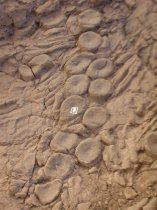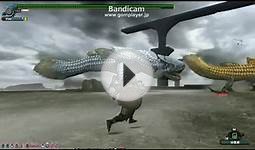New Monsters discovered
 The ichthyosaur, Shonisaurus popularis, was a school bus-size predatory reptile thought to rule the Triassic seas.
The ichthyosaur, Shonisaurus popularis, was a school bus-size predatory reptile thought to rule the Triassic seas.
Evidence for the kraken and its gruesome attacks comes from markings on the bones of the remains of nine 45-foot (14 meter) ichthyosaurs of the species Shonisaurus popularis, which lived during the Triassic, a period that lasted from 248 million to 206 million years ago. The beasts were the Triassic version of today's predatory giant squid-eating sperm whales.
McMenamin was interested in solving a long-standing puzzle over the cause of death of the S. popularis individuals at the Berlin-Ichthyosaur State Park in Nevada. An expert on the site, Charles Lewis Camp of U.C. Berkeley, suggested in the 1950s that the ichthyosaurs succumbed to an accidental stranding or a toxic plankton bloom. However, nobody has been able to prove the beasts died in shallow water, with more recent work on the rocks around the fossils by Jennifer Hogler, then at the University of California Museum of Paleontoloy, suggesting they died in a deepwater environment. [See image of kraken's lair]
"I was aware that anytime there is controversy about depth, there is probably something interesting going on, " McMenamin said. And when he and his daughter arrived at the park, they were struck by the remains' strangeness, particularly "a very odd configuration of bones."
The etching on the bones suggested the shonisaurs were not all killed and buried at the same time, he said. It also looked like the bones had been purposefully rearranged, likely carried to the "kraken's lair" after they had been killed. A similar behavior has been seen in modern octopus.
The markings and rearrangement of the S. popularis bones suggests an octopus-like creature (like a kraken) either drowned the ichthyosaurs or broke their necks, according to McMenamin.
The arranged vertebrae also seemed to resemble the pattern of sucker disks on a cephalopod's tentacle, with each vertebra strongly resembling a sucker made by a member of the Coleoidea, which includes octopuses, squid, cuttlefish and their relatives. The researchers suggest this pattern reveals a self-portrait of the mysterious beast.
The perfect crime?
Next, McMenamin wondered if an octopus-like creature could realistically have taken out the huge swimming predatory reptiles. Evidence is in their favor, it seems. Video taken by staff at the Seattle Aquarium showed that a large octopus in one of their large tanks had been killing the sharks. [On the Brink: A Gallery of Wild Sharks]
betboom.ru официальный сайт
You might also like


|
New Ladies Green colors short sleeve cotton tshirt Galileo Galilei Quote: "All truths are easy to understand once they are discovered; the point is to discover them." Apparel (Body-soul-n-spirit Shirts)
|





